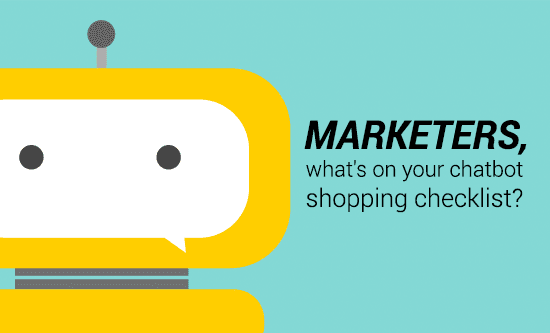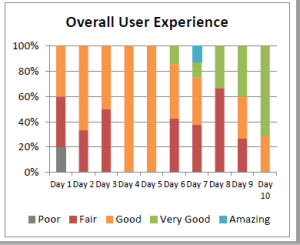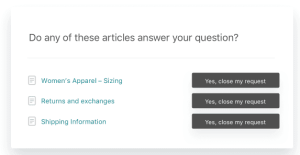Google Trends suggests that interest in chatbots may have peaked sometime in late 2017 (see below). Unsurprisingly, it has been leaders in customer service focused roles that have spearheaded recent adoptions by organizations. They have sought out this technology to help meet their cost savings and customer satisfaction goals. Yet, their marketing disciplined peers have largely undeveloped if not ignored the technology.
Accomplished marketers and customer experience leaders like Patrice Scicluna recognize the marketing potential of chatbots. During a recent chat, Patrice explained that “we originally pursued chatbots with a 100% focus on helping to meet customer service and cost reduction goals”. Patrice went on to explain that “after conferring with our marketing stakeholders, we agreed that this was an important additional marketing channel for us to pursue”.
What follows is a 5 point shopping list for what to look for when investigating chatbot vendors and integrating the new channel into your marketing ecosystem. In a ceaseless churning sea of daily new solutions, its easy to lose sight of the essential capabilities that should be on any marketer’s list.
- Detection of Transition Moments
One potential reason for the abated enthusiasm of chatbots by marketers vs. their customer service peers may be exercising caution about the perceived risk of channel abuse. While it is true that uncontrolled use of chatbots can lead to spam and alienating the customer, the best solutions are able to strike a balance between customer service and marketing objectives.
The secret to achieving balance is to ensure your selected chatbot solution is aware of transition moments and can share these moments in time with other parts of your marketing ecosystem. It’s only after a transition moment occurs that a more marketing focused message may be helpful and appropriate, as opposed to awkward, annoying or irrelevant.
A transition moment occurs when a customer’s immediate customer service question or need has been satisfied. This can either be explicitly detected by asking the customer (“Have I answered your question?”, “Is there anything else I can help you with?”) or inferred based on the confidence level of the answers provided and the conversation flow.
Examples of transition moments include:
- Explanation provided on retailer’s return policy itemized
- Details on how to redeem points on loyalty card explained
- Comparison of multiple relevant credit cards summarized
- Differences between similar pre-paid and post-paid mobile phone plans outlined
- Tandem Real-Time Marketing Support
Following the detection of a transition moment, marketers are in a position to provide meaningful and relevant messages, which align with their objectives (in particular, cross-sell and up-sell).
To take advantage of transition moments, your selected chatbot solution will require tight integration with a real-time inbound marketing solution, which is able to make recommendations in milliseconds.
To work in tandem, seamless integration of the two systems requires that the context and intent behind the conversation flow is shared. This allows inbound marketing solutions to make recommendations based on not only the current conversation, but also on a wider behavioural and predictive customer profile.
Examples of relevant messages after transition moments include:
- After an inquiry on loyalty points balance, suggest rewards that can be redeemed with that balance to boost loyalty program engagement
- Once the return policy has been explained, suggest alternative items that might be a better fit than the item being returned to increase basket size and frequency
- Upon clarification of loyalty points issuance policies, suggest an in-store event to attend based on customer’s preferred store and interests (e.g. family friendly) to drive traffic in-store
- Following a summary of various mortgage products and options to a detected first time home buyer, suggest relevant insurance products such as home or mortgage protection
- Adaptive Missing Middle
Daugherty and Wilson’s “Human + Machine: Reimagining Work in the Age of AI” describes what they call the missing middle as “the novel jobs that grow from the human-machine partnerships”¹. These are jobs and tasks that emerge when artificial intelligence (AI) solutions like chatbots are evaluated in terms of humans complementing machines or AI giving humans superpowers (“human and machine hybrid activities”).
While general AI and chatbot solution vendors (e.g. Google, Amazon, IBM etc.) emphasize the advantages of fully autonomous implementation approaches, the thoughtful orchestration of overlapping customer service and marketing communications remains most effective with a helpful human hand to fill in the missing middle. Specifically, a minimum of attentive conversation design is required.
“The simple truth is that companies can achieve the largest boost in performance when humans and machines work together as allies, not adversaries, in order to take advantage of each other’s complementary strengths. What’s easy for us (folding a towel, for instance) can be devilishly tricky for machines.”¹
Conversation design involves the mapping of the scope of the possible types of conversations a chatbot may have with the customer. This initial calibration provides a launching point for chatbot’s machine learning capabilities and reduces the time to relevancy.
As illustrated below left, a recent study conducted by Centennial College in Ontario showed how this accelerated approach was able to dramatically improve user satisfaction after 10 days of learning³.
Not all chatbot solutions are envisioned to accommodate conversation design, as they claim to make exclusive use of machine learning to map conversation flows over time. Often, the results of a fully autonomous solution can be disappointing, as they are nothing more than a search engine for articles (see below) as opposed to convincing and helpful conversations.
While a fully autonomous solution is certainly easy to implement, even a modest contribution to conversation can go a long way in improving relevancy, especially for managing queries in particularly deep or wide possible conversation flows.
- Analytics Friendly
The tight level of integration between your chatbot and your real-time inbound marketing solutions should go beyond presenting the right message during transition moments. It’s also important that the information necessary for evaluating the success your marketing decisions and supporting other marketing and analytics initiatives flows freely.
Firstly, most marketing automation systems provide interaction histories (a.k.a. “contact”, “response” and “offer” histories), which are an important component the 360 degree views of your customers. Not unlike traditional channels such as web or email, marketing messages delivered via the chatbot channel need to be funneled back into your customer information systems in a timely fashion.
Secondly, chatbot conversations offer a window into your customer’s mood and intent, which can be fed into your behavioural models and actioned as part of your existing outbound and customer life cycle based campaigns. If conversation information is not fed into your analytics systems, you could even be missing out on determining what customers are thinking, even unconsciously.
Using Google search data for the United States 2016 election, Stephen-Davidowitz, a Warton School lecturer, explains how we write search queries (or, indeed, how we interact with chatbots) can be a window into our subconscious:
“During the 2016 election between Trump and Hillary Clinton, some people searched for “Trump Clinton polls.” Others looked for highlights from the “Clinton Trump debate.” In fact, 12 percent of search queries with “Trump” also included the word “Clinton”. More than one-quarter of search queries with “Clinton”also included the word “Trump”. We have found that these seemingly neutral searches have actually give us clues to which candidate a person supports. How?. The order in which the candidates appear. “Our research suggests that a person is significantly more likely to put the candidate they support first in a search that includes both candidates’ names.”
- Customer Identity Aid
Chatbots offer a unique opportunity to help identify (or partially identify) customers that would ordinarily be completely anonymous. Many chatbot solutions offer low friction methods of authentication (e.g. email, social login) that customers are likely to use when provided an incentive, such as emailing a copy of a chat transcript to themselves, or to open and track support tickets.
For the marketer, this is a sometimes rare and valuable opportunity to identify prospects and existing customers that would normally be treated without the full benefit of access to customer profiles and histories. Once anonymous customers are identified, this opens up the possibility of more personalized acquisition campaigns, which can be a particular challenge for B2B organizations.
Head to the Market
In addition to the 5 shopping list items above, there are a variety of additional capabilities to consider, such as enabling rich content, instant messaging integration, in-chat completion of transactions and support for on-premise installations.
If you have your list and you’re still struggling to agree on an approach, please contact us at Digital Alchemy to learn more about how we have introduced chatbot solutions with a focus on the marketer’s needs in mind.
Digital Alchemy’s uDecide real-time marketing tool and KORAH’s ccRobot chatbot are one example pair of solutions that meets the 5 point shopping list criteria, and more. These solutions are available for custom demonstrations tailored to your industry and organization.
¹ Daugherty, P. R. & Wilson H. J. (2018). Human + Machine: Reimagining Work in the Age of AI. Boston, MA, Harvard Business Review Press pg. 106
² Stephens-Davidowitz, S. (2017). Everybody Lies: Big Data, New Data, and What the Internet Can Tell Us About Who We Really Are. New York, NY, Harper Collins pg. 10
³ Study by KORAH Limited in conjunction with WIMTACH (Wearable, Interactive, Mobile, Technologies Acess Centre in Health) of Centennial College, Ontario, Canada.
 by Joe Maraschiello, Business Development & Region Director at Digital Alchemy.
by Joe Maraschiello, Business Development & Region Director at Digital Alchemy.



